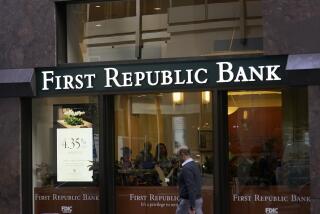FDIC ‘Not Broke,’ Seidman Says : Banks: The top regulator challenged the assertion by the comptroller general that the fund is nearly insolvent.
WASHINGTON — The top regulator of the nation’s bank insurance fund Sunday denied a claim by the U.S. comptroller general that the fund is nearly insolvent, saying the auditor’s conclusion was based on a faulty application of accounting rules.
“It’s not broke,” L. William Seidman, chairman of the Federal Deposit Insurance Corp., said of the fund. Responding to the dire picture painted by Comptroller General Charles Bowsher, Seidman said, “We don’t agree with him.”
Bowsher, the government’s top auditor, said in a report delivered to Congress on Friday that many more banks are insolvent than the FDIC has recognized. He suggested that Congress inject an extra $15 billion into the insurance fund through a special assessment on banks. Bowsher heads the nonpartisan General Accounting Office, which must report once yearly to Congress on the state of the bank fund.
The GAO study looked at the 368 troubled federally chartered banks and found 71 to be nearly insolvent. Bailing them out would cost the fund $7 billion to $11 billion, the report found.
According to Seidman, the GAO calculated what it would cost to bring the banks in line with federal capital-reserve requirements, then deduced from that which were insolvent. But the FDIC’s view is that it should postpone accounting for some losses that the GAO believes should already have been recognized.
“It’s an argument between accountants, about when we should pick up some losses,” Seidman said. “It’s not real losses. . . .”
His comments were made Sunday morning on ABC’s “Business World” program.
The GAO report was the most pessimistic of a long line of analyses of the bank fund that has been presented to Congress over the past year.
Seidman said the deposit insurance fund has $7 billion in cash on hand and is entitled to borrow another $5 billion from the U.S. Treasury Department.
He said he believes that the fund will be solvent when the next federal fiscal year begins this fall, despite the $2.5-billion cost of closing down Bank of New England. The troubled bank was sold last week to Fleet/Norstar Financial Group and Kohlberg Kravis Roberts & Co.
“We could handle another Bank of New England, but don’t ask me if we could handle two of them,” Seidman said. “The fund is obviously going down because of the effects of the recession on banks. . . . It would be very tight if we had two of that size.”
But Seidman added that he does not expect that another bailout of that size will be necessary this year.
The bank fund guarantees bank deposits up to $100,000. It would continue to offer such protection even if bank contributions weren’t enough to keep the fund solvent. But the money would then come directly from the Treasury--that is, from the taxpayers.
More to Read
Sign up for Essential California
The most important California stories and recommendations in your inbox every morning.
You may occasionally receive promotional content from the Los Angeles Times.










